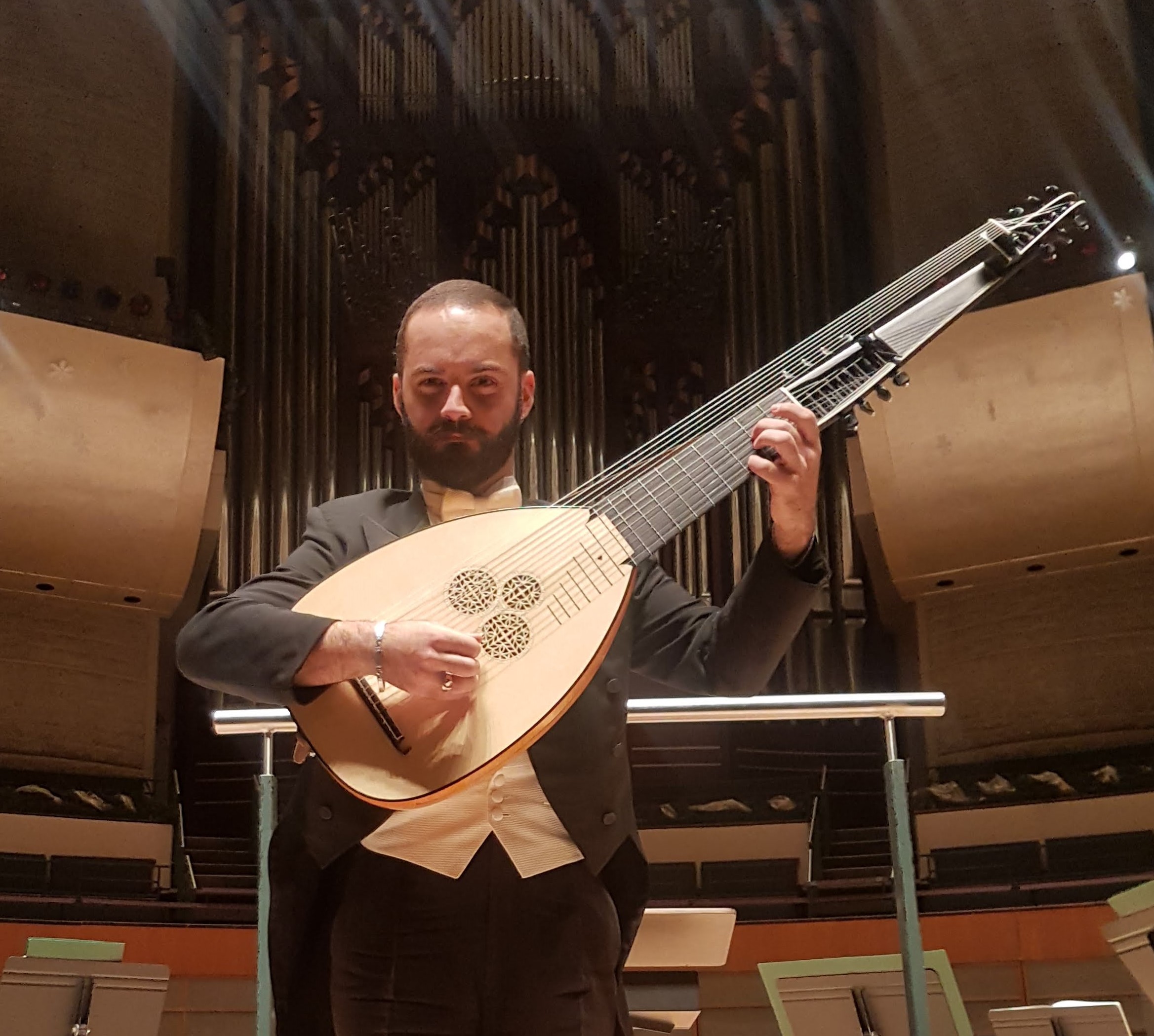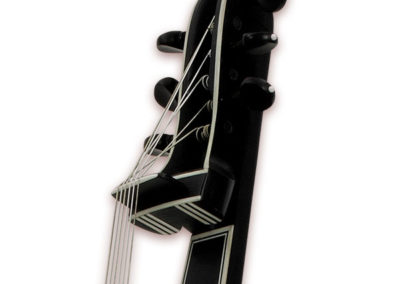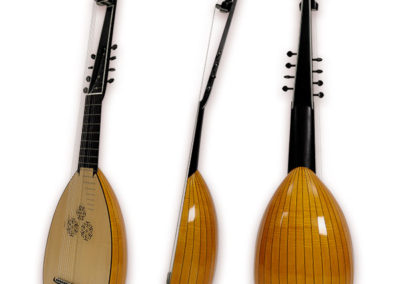Arciliuto forte in g
(Italian baroque lute / Archlute)
Repertory: all compositions for arciliuto from 1600 to about 1750, all compositions for 6-10 course alto lute from 1500 to about 1630, arrangements of compositions for d minor lute, music of the 19th to 21st century, continuo
14-stringed: F G A B flat C D E F G c f a d‘ g‘
- String-length fingerboard strings 62,5 cm, String-length bourdon strings 96 cm
- Choice of 7 or 8 fingerboard strings
- a’ = 415 oder 440 Hz
- Single stringing
- Slightly curved fingerboard
- 17 fixed frets (tied-on if desired)
- Veneer extension inlaid edges
- Triple rose, broad body, 19 ribs
- Traditional or geared pegs
- Wood: Rosewood, Maple, Yew
(recommended: Maple or Rosewood)
The Arciliuto in g with 8 fingerboard strings can also be strung as a Liuto forte in d or e. In contrast to the Liuto forte in d the fingerboard of the Arciliuto in g is only slightly curved.

Liuti forti are delivered directly from the manufacturer and are not available from music shops.
If you would like to order a Liuto forte or need advice please send us an email.
If you wish, we can also put you in touch with Liuto-forte players in your area.
Archlutes played a significant part in the ensemble-music of the 17th and 18th century, as well as in vocal accompaniment. They also generated a remarkable soloistic repertoire. Its very long bass strings were always single, while the fingerboard strings came sometimes in double courses and sometimes single.
The sometimes extreme length of the open bass strings of historical archlutes is due to the fact that at the time of the invention of these instruments there were no bass strings wound with metal. The bare gut or metal strings common at that time had to have a certain length in order not to become too thick and thus sound dull. Since Liuti forti in the bass, however, are all equipped with wound strings, these highly impractical, extreme extensions can be dispensed with in our instruments. In contrast to historical archlutes, Liuti forti with extended bass strings do not show any break in sound at the transition from the fingerboard strings to the bordun strings.
The archlute proper is to be carefully distinguished from the instrument known as ”liuto attiorbato”, which was a small instrument also in the G tuning and furnished with lengthened bass strings. Italian composers of the 17th century have left a considerable solo repertoire to be played on its comfortable short string-length, which if attempted on the archlute and its longer mensuration would prove problematic for the left hand.
The Arciliuto forte in g, however, which due to its soundboard construction can exceed an historical archlute in volume, can be given a shorter string-length without losing its penetration. It is thus equally able to fulfil ensemble duties and to interpret the delightful music for the liuto attiorbato. Due to its power, brilliance and timeless beauty the Archlute remains among our most popular models.
By choosing an Arciliuto forte in g in the tuning G A B C D E F G A c f a d’ g’, you can not only enjoy an immense reduction of fingering difficulties in the reproduction of the instrument’s original repertoire; you can also comfortably switch to the d minor tuning by exchanging only two strings. The transition from archlute to an instrument in the d minor tuning then demands no more acclimatization to the new bass register than in the case of a transition from archlute to theorbo, whose sixth string is also tuned to an A.
Samples
Please note that when recording with Liuti forti, there is no difference between the sound of the instrument in the recording and the sound of the instrument in the original. If you wish, compare the sound of the respective pieces with recordings of the same piece on copies of historical lutes that can be found on the Internet.
Hieronymus Kapsberger,
“Toccata 6 for Lute”
Luciano Còntini, Lutenist, Austria,
Arciliuto forte in a (415 Hz) resp. g (466 Hz), Rosewood, played with nails
J.S. Bach “Prelude BWV 998”
Luciano Còntini, Lutenist, Austria,
Arciliuto forte in a (415 Hz) resp. g (466 Hz), Rosewood, played with nails
Danse de noir
Ingo Hampf, Lutenist and Guitarist
Arciliuto in g, Rosewood
Played with nails

Francesco Bartolomeo Conti
“Cantate con istrumenti I-IV”
Bernarda Fink, Mezzosopran, Ars Antiqua Austria, Dir. Gunar Letzbor
Edition ARCANA/WDR3, P 2002
Luciano Còntini, Lutenist, Austria,
Arciliuto forte in a (415 Hz) resp. g (466 Hz), Rosewood, played with nails
Christophe Rocher, Lutenist, France
Archiliuto forte in g (415 Hz), Rosewood, played with nails (part 1)
Christophe Rocher, Lutenist, France
Archiliuto forte in g (415 Hz), Rosewood, played with nails (part 2)

“Sí Bheag, Sí Mhór”
Konstantin Bozhinov, Lutenist, Canada
Arciliuto forte in g, (415 Hz), Maple, played with nails
“The Silly Wizard Set”





